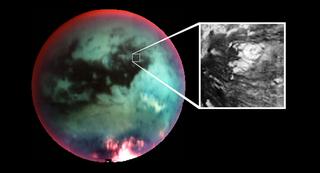
This false-color mosaic of Saturn's largest moon Titan, obtained by Cassini's visual and infrared mapping spectrometer, shows what scientists interpret as an icy volcano (see inset). The mosaic was constructed using six medium-resolution infrared images, obtained during Cassini's flyby of the hazy moon on Oct. 26, 2004.
The colors correspond to atmospheric (red) and surface (green and blue) features that are not visible to the human eye. The inset shows a high-resolution image taken using a 2.3 micron filter near the point of Cassini's closest approach to Titan at 1,200 kilometers (746 miles). The resolution in this inset image is 2 kilometers (1.2 miles) per pixel. The image scale of the large image is 25 kilometers (16 miles) per pixel.
The Cassini-Huygens mission is a cooperative project of NASA, the European Space Agency and the Italian Space Agency. The Jet Propulsion Laboratory, a division of the California Institute of Technology in Pasadena, manages the mission for NASA's Science Mission Directorate, Washington, D.C. The Cassini orbiter and its two onboard cameras were designed, developed and assembled at JPL. The visual and infrared mapping spectrometer team is based at the University of Arizona.
For more information about the Cassini-Huygens mission visit http://saturn.jpl.nasa.gov. The visual and infrared mapping spectrometer team homepage is at http://wwwvims.lpl.arizona.edu.
NASA/JPL/University of Arizona
